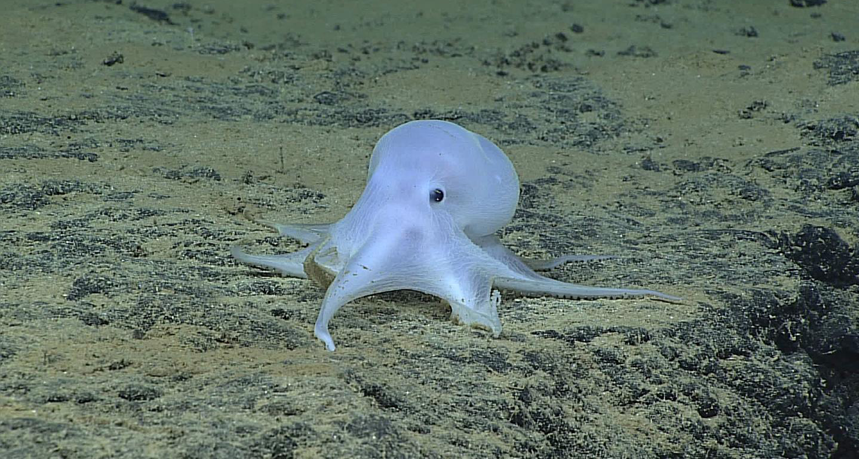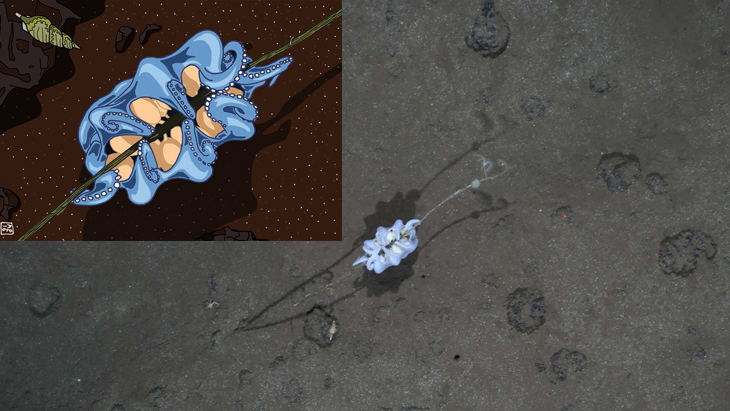Deep-sea mining could imperil rare, ghostlike octopus
Newly discovered octopus lays its eggs where miners are looking for valuable metals

This ghostlike octopus was only recently discovered deep at the bottom of the ocean off an island near Hawaii. It makes its home at a site being eyed for deep-sea mining.
Courtesy of NOAA Office of Ocean Exploration and Research, Hohonu Moana 2016
Scientists released the first photos of a squishy, semi-transparent octopus last spring. Adults are about the size of an open human hand. Because of its haunting appearance, the scientists nicknamed it Casper, after the cartoon ghost. Now some researchers worry that these animals could soon disappear for real. That’s because these animals lay their eggs where companies are looking to mine valuable metals for use in electronics.
Autun Purser is a marine ecologist. As such, he studies the relationship of marine creatures to each other and their environments. Purser works at the Alfred Wegener Institute in Bremerhaven, Germany. In 2015, he and his team spent five weeks exploring the deep seafloor near where Casper had been photographed. This was in the South Pacific, off the coast of an island near Hawaii.
At this spot, rocky nodules litter the seafloor. They look a bit like potatoes. These nodules contain metals such as manganese, which are used to make electronics. And that interests mining companies, looking to supply electronics companies. If mining teams go after them, their activities might accidentally disrupt the environment that nurtures Casper and his kin.
“The nodules grow like pearls,” explains Purser. “They usually start growing over a shark’s tooth or a bit of broken shell. Slowly, over time, they form layers of rock.” These layers tend to include some of the metals now used in cell phones and computers.
While these metals can be found on land, rich deposits on land have already been mined. There is currently no deep-sea mining for these metals. But companies are considering it. “We thought we should try to understand what animals are in the area before we start mining,” Purser now reports.
His research team sent a swimming robot down to the seafloor. This site was more than 4 kilometers (about 2.5 miles) below the surface. The robot towed a camera, which took pictures. Those photos turned up 29 octopuses from two different species. Two individuals were curled around their eggs. This egg protection behavior is known as brooding.
The octopuses had laid their eggs on the dead stalks of sea sponges. Those stalks resemble stiff blades of grass. Purser suspects the octomoms may guard their eggs like this for more than a year. That guess is based on work by other researchers who had monitored a similar octopus in shallower water. It had laid its eggs on the edge of an underwater cliff. The researchers sent down a camera every month to check on it. It took more than three years before its eggs hatched.
Story continues below image.

Unfortunately for Casper’s species, the sponges where it lays its eggs grow atop the rocky nodules that mining companies have begun eying. The octopuses also seemed to feed around the nodules and to hang out in seafloor structures, such as surface cracks and the metal-rich nodules.
Deep-sea mining for metals might one day take place across large sections of the seafloor. Powerful vacuums might suck up nodules and bring them to the surface. Or perhaps a system of dredgers or buckets attached to a conveyer belt would haul up the nodules. Either way, the process would likely wreak havoc on the seafloor ecosystem to which these octopuses belong.
The broad scale of mining being considered might one day “impact areas the size of small countries” — and do that every few years, says Daniel Jones. He is a marine biologist with the National Oceanography Centre, in Southampton, England. He has studied similar environments in the eastern Pacific, including areas with manganese nodules. It’s important that biologists learn what’s living in these areas and the ecosystem impacts of mining, he says, so that companies can make wise decisions on where it’s safest to mine metals.
Jones says Purser’s work “is critical for enriching our understanding of this poorly-known deep-sea environment.” The octopus researchers, he adds, “are not only revealing important information for marine biology but also bringing to life an enchanting character in the complex story of life in the deep sea.”
The Alfred Wegener team has some idea of what might be at stake. In the mid-1980s, other researchers from their institute pretended to mine the seafloor near Hawaii. They dragged a type of plow across roughly one square kilometer (0.4 square mile) of seafloor. This wiped it clear of nodules. Then they waited see how long it took for the seafloor to return to its pre-mined state.
Purser and his team are now investigating the differences between the plowed and unplowed sites. They have yet to analyze all of their data. But as far as they can tell, even after 30 years none of the nodules have returned. That means no sea sponges. And no sponge stalks on which Casper’s kin can lay their eggs.
If companies do mine the seafloor, Purser hopes they will do it in small patches. That should preserve large areas of nodules. “It would be nice to say don’t do any mining,” he says, “but we all use mobile phones.”







